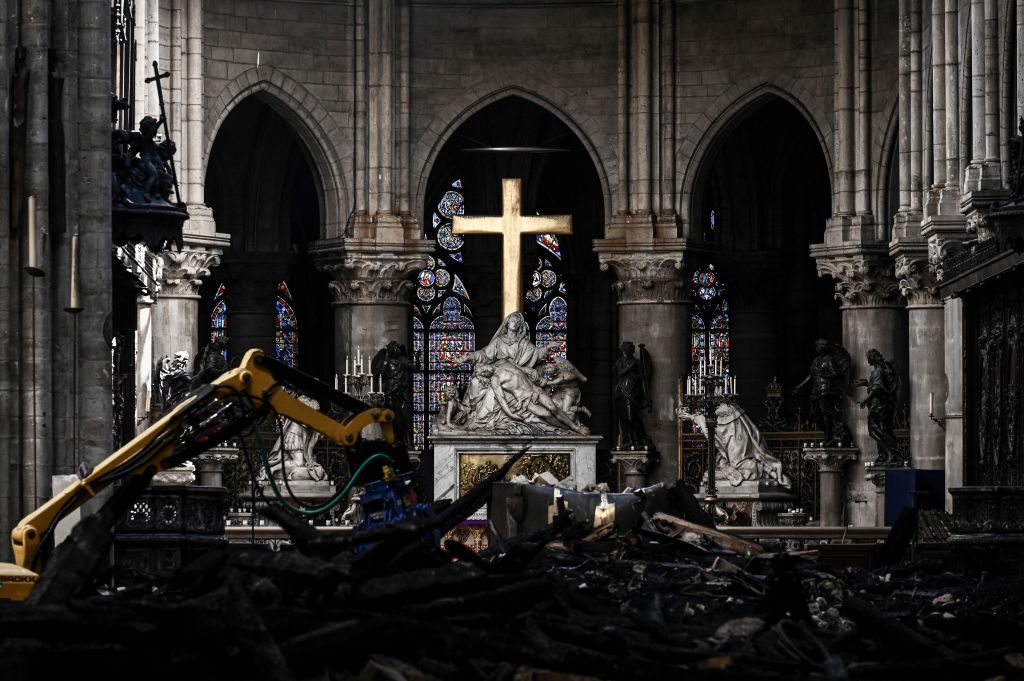The shiny new interior. Christophe Petit Tesson/Pool/AFP/Getty Images
Who, save for the most embittered cynic or those who ritually deprecate Western culture, could do anything other than raise a cap, beret or biretta, metaphorical or real, to those who have rebuilt Notre-Dame? Who is unable to salute the ingenuity and skill of engineers and craft workers who have resurrected it? We might even give praise to the politicians, Emmanuel Macron first among them, his very name meaning “God is with us”.
This weekend witnesses a re-opening ceremony and a concert attended by heads of states as well as by the US president-elect Donald Trump — if not by the Pope who believes his presence might be a distraction. On Sunday, there will be a celebratory mass. Accompanied by TV cameras, Macron has already walked through and up the renovated cathedral. Addressing some 1,300 craft workers he said: “The shock of the reopening will be as great as that of the fire.”
It is hard to disagree. In the words of the late Kenneth Clark — “Lord Clark of Civilisation” — Notre-Dame is “not perhaps the most lovable of cathedrals”, yet its scale and geometric rigour, its long and dramatic history, and its sheer presence on the Île de la Cité have made it a magnet for countless millions of people of whatever faith or none from around the world. For Parisians, and the French at large, the cathedral fire was nothing less than a national tragedy. Notre-Dame is a symbol of the city, an architectural and ecclesiastical patroness for the country even.
And yet, watching videos and studying photographs of the interior of the restored building, it seems as if hundreds of years of history have been somehow disinfected and washed away. Notre-Dame nouvelle seems so very shiny, so antiseptically bright, especially with its glistering procession of gilded electric chandeliers. Strangely, given the construction of its great nave began almost 850 years ago, it appears all but brand new. Those scrubbed walls and vaults. That gleaming floor. Those vibrant colours: reds and lapis lazuli blues.
While unsettling, this sense of the revamped Notre-Dame being more of a grand civic hall than a place of worship makes a certain sense. Since the French Revolution, the state has pretty much owned Notre-Dame, lock, stock and spire. Its fortunes and its appearance have oscillated with the swings of the political pendulum.
In 1793, Catholic worship in Paris was banned. The philosophical reasoning had been long in the making. “Every sensible man, every honourable man, must hold the Christian religion in horror,” declared Voltaire. “Man will never be free until the last king is strangled with the entrails of the last priest,” railed Denis Diderot. These writers died before the storming of the Bastille and the ministrations of Madame Guillotine in the Place de la Révolution, yet their influence on the course of late 18th-century French politics and culture was profound.
The mob in their Jacobin caps stormed Notre-Dame. Early 13th-century statues of 28 Kings of Judea adorning the west facade were wrenched down and decapitated. The baying anti-clerics mistook them for kings of France. The interior of the cathedral was looted and then used, among other secular purposes, as a wine depot. In November 1793, a pointedly paganistic Festival of Reason was held in the nave.
“Religion,” the Franco-German philosopher Baron d’Holbach had written from his apartment in the Rue Royale, “has ever filled the mind of man with darkness and kept him in ignorance of the real duties of true interests.” This darkness would be dispelled by the bright light of Reason, although at the time there were no gilt electric chandeliers to do the job on behalf of French philosophy and the Revolutionary state.

Soon enough, Notre-Dame was auctioned off to a building merchant. This ignominious sale was cancelled by Napoleon Bonaparte when, seizing power in 1799, he disbanded the Revolutionary government. The dynamic young general had Notre-Dame redecorated for his coronation in 1804. Not that the new French emperor had any great love for the Church. While under construction in the style of a Graeco-Roman temple, Napoleon decreed that the vast new church we know as La Madeleine should be designated the “Temple to the Glory of the Grand Army”. Even with Napoleon defeated on the battleground, exiled, dead and gone, plans were made to complete the Corinthian temple as a railway terminus. It was finally consecrated as a Catholic church in 1842 when Louis Philippe I was on the throne.
It was during Louis Philippe’s reign that Victor Hugo’s Gothic novel The Hunchback of Notre-Dame was published, sparking a popular call for the conservation of medieval architecture and, especially, the cathedral itself. From 1844, the architects Eugène Viollet-le-Duc and Jean-Baptiste Lassus were charged with the complete restoration of Notre-Dame, while France underwent another revolution with the appointment of its first president, Louis Napoleon, in 1848, and crowned emperor four years later,. Funded by the government, the restoration project symbolised a remarkable turn in the cathedral’s fortunes. During the July Revolution of 1830 that had brought Louis Philippe to the throne, the damage caused to the building was so great that Parisian officials had seriously considered demolishing it.
Whether Revolutionaries, kings, emperors or presidents, Notre-Dame has certainly been something of a plaything of French rulers.. The top-down handling of the cathedral is perhaps a reflection of French cultural politics. It is a French way of doing things that has not gone away. Ever since 1958 and the birth of De Gaulle’s Fifth Republic, French presidents, as embodiments of “the spirit of the nation”, have used architecture and its conservation as a conspicuous political tool.
Think of all the “grand projects” of successive Fifth Republic presidents. There was Georges Pompidou’s modernising Centre Pompidou, Valéry Giscard d’Estaing’s Musée d’Orsay, and François Mitterrand’s Louvre Pyramid. These buildings established their cultural credentials, their largesse and semi-regal power, and aligned them with the very kings, queens and emperors republicanism had overthrown. Their names are attached like stone plaques to these cultural monuments. Now, there’s Emmanuel Macron’s championing of Notre-Dame.
Arguably no one did this better than President de Gaulle, who left matters monumental to France’s first Minister of Cultural Affairs, André Malraux. Novelist, art philosopher and genuine wartime Resistance hero, Malraux is the kind of minister of culture we may never see again: Not only cultured, but brave too. An agnostic, he believed in aesthetic spirituality —that through the artistry of its design and construction, a secular building can convey a sense of the numinous, while in churches visitors can experience this same spiritual feeling without professing a faith.
Significantly, Malraux gave the oration at the 1965 state funeral of the architect Le Corbusier. It was held not in Notre-Dame but in the Cour Carrée of the Louvre, the museum founded by the Revolutionary government in 1793 to display great works of French art including those confiscated from the nation’s churches. An atheist, Le Corbusier designed the pilgrimage chapel of Notre-Dame du Haut at Ronchamp. A building of great originality, its lyrical profundity haunts the hillside on which it stands. Under its shell-like roof, it shrouds an interior lit as if by some latter-day angel.
If this hillside chapel close to the Swiss border has a far greater sense of sacred mystery than the restored Notre-Dame in Paris, perhaps this should be no wonder. It is not a grand state monument. It is not presidential. This, for better or worse, and for all the heroism and craftsmanship involved in its reconstruction, is the fate of Notre-Dame. Of course, the freshly unveiled cathedral will be popular with the crowds and congregations, who will throng here from this week. Certainly, it is wonderful to hear its bells ringing across the Seine again. It just appears to be that little bit too political, too civic and, spiritually, a little cold. But that, in the end, is its purpose. Whether or not the restored Notre-Dame is enough to save or redeem President Macron, or to allow him to rise like a phoenix in years to come, is another, quite secular, matter.








Join the discussion
Join like minded readers that support our journalism by becoming a paid subscriber
To join the discussion in the comments, become a paid subscriber.
Join like minded readers that support our journalism, read unlimited articles and enjoy other subscriber-only benefits.
SubscribeYes, I was as shocked by the sterility. Perhaps even more than by the fire. Kraken dressed up as Phoenix – Terrifying!
The way the author has described the sense of spirituality shining forth without the need for any religious underpinning is admirable.
This is precisely how i see – and feel – things. I happened to be in Chichester (Sussex) earlier this week and if there’s a cathedral i haven’t visited before, i have to pay a visit. Inspirational as ever; a testament to man’s skill, ingenuity and perseverance. Unlike it’s Parisian counterpart, it stands virtually unchanged from its early medieval origins within the confines of a small English city; no need to make any statements or embellishments. It just is.
I made a contribution to its upkeep (by credit card these days) and also looked down through a section of reinforced glass flooring above a Roman mosaic, taking us back even further into our history.
I’m pleased to see Notre Dame restored and re-opened, but the idea it might enhance Macron in the eyes of anyone who’s been following his trajectory is ridiculous. As the spires have soared above Ile de la Cité once again, his aspirations have crashed and burned. This faux-emperor will be leaving no mosaics to admire 1500 years or so hence.
The Fifth Republic will leave its own grubby marks behind so perhaps it is fitting that the great symbol of Paris now looks so pristine. The horrors it has witnessed over the centuries need no sooty reminders…if all is shiny and bright, glowing with colour, perhaps we can bask in it for a moment or two, until reality kicks in.
Its sterility is a perfect metaphor for modern, deracinated and spiritually barren France. But at least they didn’t make it a mosque.
This is exactly what was said about the restoration of the ceiling of the Sistine Chapel.
Completely off-base.
…yet?
A mosque would have been an improvement.
— “Man will never be free until the last king is strangled with the entrails of the last priest,” railed Denis Diderot.—–
This stance did not prevent him from accepting the generous (and regular) financial support from Catherine the Great of Russia.
Intellectuals, n’est-ce pas?… [sigh]
As Augustine confessed: “Oh, Master, make me chaste and celibate – but not yet!”
My understanding is that the stone gleams as if new because they have cleaned off the ash and dust from the fire. Call it sterile if you will but the result is the cathedral as it was originally conceived. That may be no bad thing.
Many were also shocked after the Sistine Chapel was restored as people were used to the yellowing brown figures, but I thought, it was marvellous to see the original Michelangelo colours.
I leave my verdict till I have seen the “new” original version.
Great, and now they can get cracking on the rebuilding and restoration of the great Benedictine Abbey of Cluny, another victim of the French Revolution. It was the largest church in the world for centuries, before St Peters in Rome was rebuilt.
https://www.youtube.com/watch?v=oWQ-334AA1g
That page shows a terrific animated 3D reconstruction of the abbey, whose style seems to match that of Notre Dame quite closely. But the narration is in French.
“Emmanuel Macron … his very name meaning “God is with us”. That is indeed the Hebrew etymology of “Emmanuel”. Etymology has little predictive value in this context. The word “macron” has Greek etymology and means “long (in time)”, hardly descriptive of his various prime ministers’ durations.